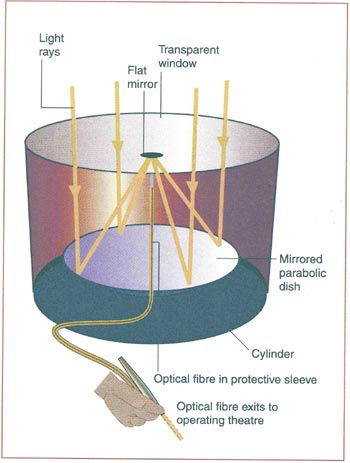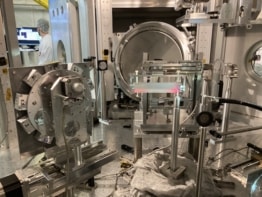Laser surgery is a familiar technique in hospital operating theatres. Now, however, researchers at the Ben-Gurion University of the Negev in Israel have made improvements in “solar surgery”, a new technique that uses highly concentrated sunlight instead. The technique can produce the same changes in biological tissue as conventional laser fibre-optic surgery and could provide a cheap alternative to this method (J M Gordon et al. 2003 J. Appl. Phys. 93 4843)

Laser light is used in certain medical procedures such as the removal of cancerous tissue. The growths, which are normally between a few mm to a few centimetres in diameter, are killed by high and localized rapid heating. The laser light is coupled into an optical fibre that is threaded through a catheter to the tissue being treated. However, this method can be expensive which has limited it to being used more widely.
Last September, the Israeli team led by Jeffrey Gordon, reported that it had built compact solar fibre-optic “concentrators” that provide the same power levels and densities as laser optic fibres. The concentrator consists of a parabolic mirror 200mm in diameter and with a focal length of 120 mm. It concentrates solar radiation into an optical fibre 1mm in diameter and up to 20m long (see figure). The researchers were able to produce several watts of concentrated sunlight at flux levels 10000 times that of a normal solar beam.
Visible and near-infra red wavelengths have certain advantages over infrared or ultraviolet radiation; commercial optical fibres with high light transmissivity are easily available; and the optical penetration depth is much greater. Moreover, the absorption spectrum of biological tissue is well suited to the spectrum of solar radiation.
Now, the scientists have managed to use their technique to carry out surgery on chicken livers. In one experiment, the end of the fibre was placed in a protective glass sleeve that was inserted directly into the organ. In another “non-contact” experiment the livers were sandwiched between two glass slides and the fibre tip placed against the upper slide.
The researchers focused the solar beam on the sample surface for up to 360 seconds and then measured how much the tissue had coagulated, which shows that cells in the tissue have been killed. The beam varied in power from 2W to about 6.5W and lesions of approximately 1000 mm3 were observed penetrating deep inside the tissue – roughly the same size as the lesions treated in tumour surgery.
The team has now embarked upon clinical trials on live animals. “Our first successful solar surgery on live animals was performed in January 2003,” Gordon told PhysicsWeb. “We are continuing with these trials. Thus far, our lab work is restricted to livers because our surgical partner is a liver surgeon but in principle, solar surgery could be developed for a far broader range of applications.”



